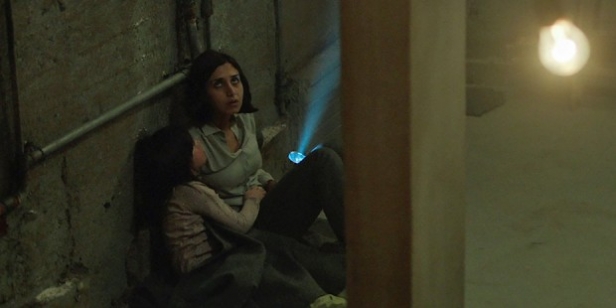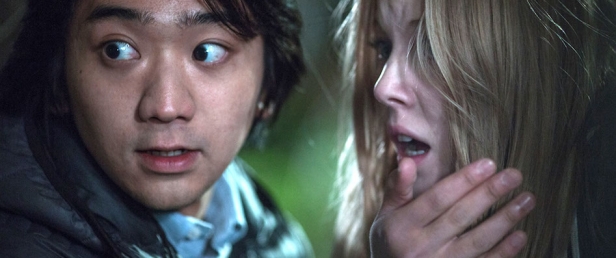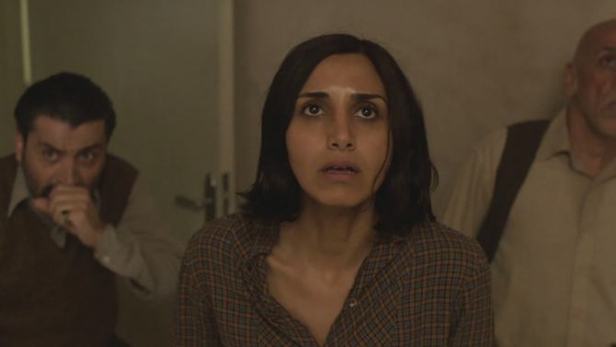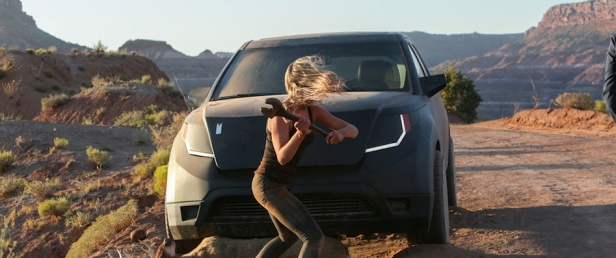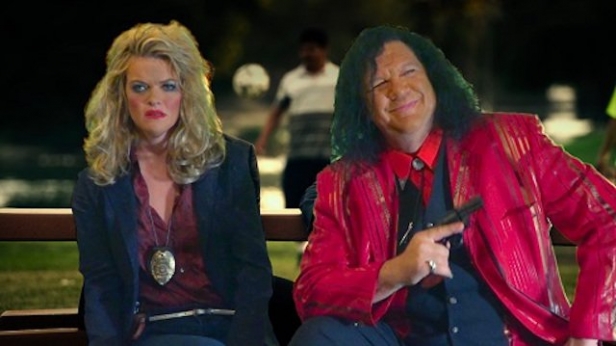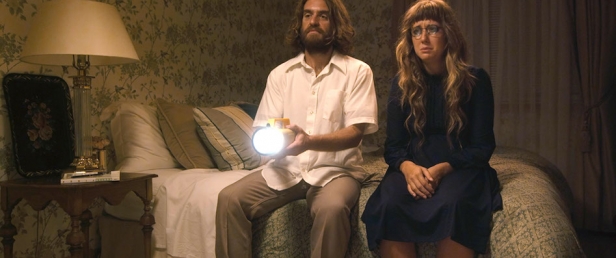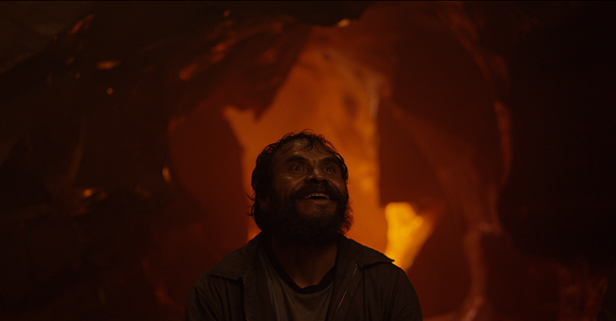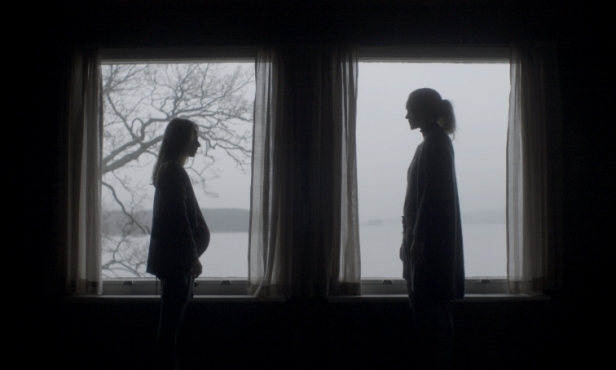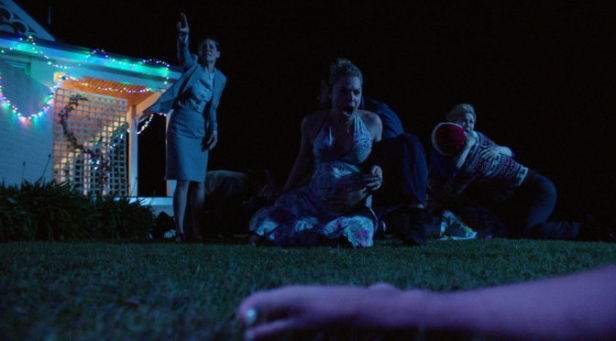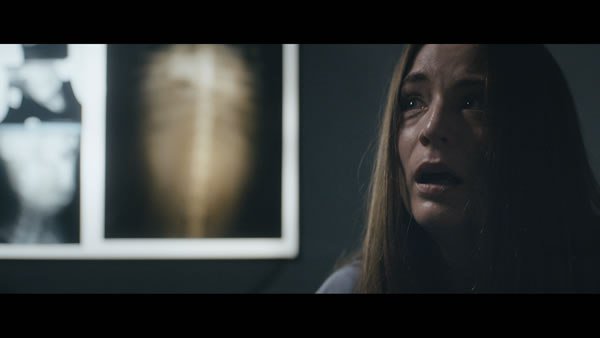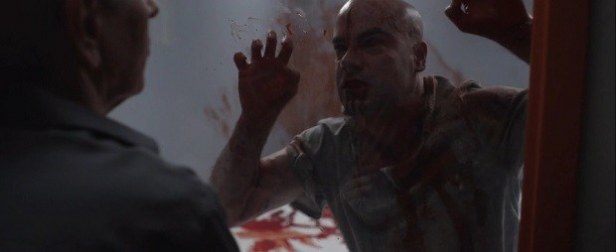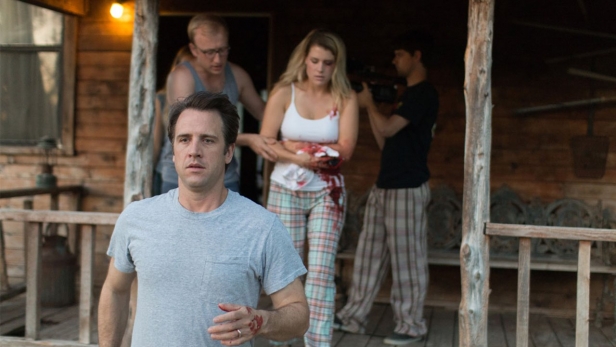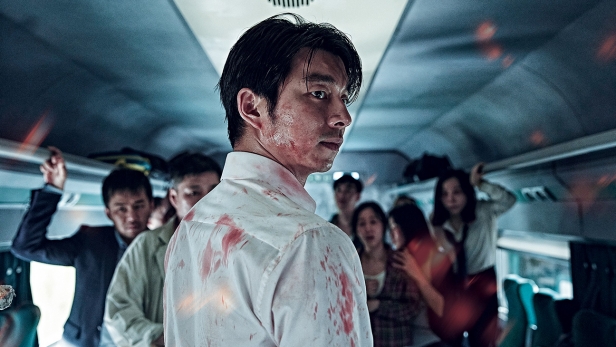Somehow the final day of Horror Channel FrightFest 2016 was already upon us, and the fifth round of genre goodness from around the world promised some of the very best of the fest. So, for one last time, we headed to the Vue Shepherd’s bush and into Holland, not hell…
First up was Dutch slasher throwback The Windmill Massacre. The feature directing debut from Frankenstein’s Army producer Nick Jongerius finds a bus-load of visitors to Amsterdam stranded in the middle of the countryside with a flat tire. Seeking shelter in a nearby windmill, they’re about to find out that the owner is not happy to see them…
With a promisingly retro set-up and an eclectic cast including the great Noah Taylor, we were cautiously optimistic about this and, although there’s some schlocky fun to be had, caution is definitely advised. The blend of axe-murders and guilty consciences does conjure up warm memories of Amicus guilt trips, as our characters realise that there might very well be a reason why they’re stranded in this deadly locale, and, of course, 80s slashers, with plenty of gruesome uses of farming implements, and there’s a solid lead turn from Broadchurch‘s Charlotte Beaumont, but it’s neither particularly funny nor particularly scary. Some decent performances, good splatter and energetic direction push it along, but we were a bit disappointed.
Meanwhile in the discovery screen, Babak Anvari’s Under The Shadow was absolutely superb and our pick for film of the festival. Tehran, 1988, and the Iran-Iraq war is raging. Shideh (Narges Rashidi) is struggling with the fact that her political past means that she cannot resume medical school, a frustration that causes friction between her, her husband Iraj (Bobby Naderi) and her young daughter Dorsa (Avin Manshadi). When Iraj is conscripted, he begs Shideh to take Dorsa and leave their apartment block and head to the hills but she refuses. As the missiles get closer, a strange presence begins to make its presence known…
Comparisons with The Babadook are inevitable, as well as The Devil’s Backbone, and this is a film that deserves to be in that esteemed company, but it’s also a powerful, complex and very, very scary film in its own right. Rashidi is superb as Shideh; sympathetic but not sugarcoated, a woman who’s been held back by the society she lives in, but never reduced to a statement. Her relationship with her daughter feels incredibly honest in its affection and difficulty, and it makes the terror all the more affecting. The spectre of conflict is a constant and oppressive presence, from the tape on the windows to the power cuts that precede the sprint to the basement bomb shelter. As for the supernatural, Anvari keeps his spirits just out of sight, in the corner of the frame, so that we’re never sure if something’s there…until it moves.
It’s incredibly tense stuff, and when the film wants to frighten you, it really does. Emotionally rich, politically sharp and absolutely terrifying, this is superb horror with has modern classic written all over it.
Then we were back to the main screen and the world premiere of Ivan Silvestrini’s Monolith. Pop star turned full time mum Sandra (Katrina Bowden) is driving her young son to her mother in law’s house in a brand new Monolith, a car with brilliant AI and an impregnable vault mode. It’s the latter that proves to be a major problem when she finds herself locked out in the middle of the desert, with her child still in the back seat…
First of all, it has to be said that Monolith looks and sounds spectacular on the big screen, as Silvestrini and his cinematographer Michael FitzMaurice do justice to the beautiful desert landscape. Although the car is called Lilith, the AI is not inherently evil and it’s Sandra’s own carelessness that is her undoing, leaving her to try and find her way in to save herself and her son, like a Buried in reverse. The problems lie in the script, which relies on some occasionally pretty terrible decision making from Sandra, and which also gives Bowden (Tucker And Dale Vs Evil) too many soliloquies that puncture the atmosphere. However, it definitely has its moments, some striking imagery and the actress gives a strong physical performance. A solid stranded thriller, even if it is a little bit too much like an endurance test at times.
The morning also saw the third and final set of excellent short films. The shorts are always a brilliant part of the FrightFest experience and this year’s selection was no different, with filmmakers like Cat Davies, Dan Savage, Bryan Lonano, Preston Nyman, Fabien Dubois and more showing their latest work (we really enjoyed Sam Ashurst’s atmospheric Hell’s Garden, a great creepy effort with an ace twist).
Up next in the main screen was the highly anticipated Director’s Cut, the none-more-meta horror comedy from director Adam Rifkin (Detroit Rock City, Chillerama) and writer Penn Jillette. The funny conceit finds crowd-funding wannabe filmmaker Herbert Blount (Jillette) giving his own director’s commentary over the film he put some money towards, pointing out the stereotypical characters, bad acting, and generally fawning over Missi Pyle (herself). However, his editorial choices, such as slow-motion close-ups of Pyle, become increasingly sinister…
Although the idea of a director’s commentary weirdly feels a little dated now, Director’s Cut is very funny and very sharp; satirising the kickstarter process, depicting an ego-laden low-budget movie set, and eventually becoming a really quite creepy horror movie. The commentary concept does start to wear a little thin, but Blount’s inclusion of his own homemade footage in his cut keeps things fresh (and more than a little unnerving). Similarly, although we’ve seen actors playing monstrous versions of themselves before, Pyle (Galaxy Quest, Dodgeball) sinks her teeth into the role of “Missi Pyle” with great relish, and Harry Hamlin is an absolute delight. Fun cameos include Lin Shaye as the no-bullshit police captain, and an extremely vocal Teller as a murder suspect who gets a little too excited by the line of questioning. Director’s Cut does threaten to outstay its welcome and the concept is overstretched by the 90 minute running time, but it’s got enough laughs and enough weirdness to make it worth a look.
In the discovery screen, writer-director duo Michael Borowiec and Sam Marine’s Man Underground was a tense and affecting drama with three very strong performances. Willem Koda (George Basil) is a conspiracy theorist looking for a way to get the truth out there, so when his friend Todd (Andy Rocco) suggests that they make a fiction film to make his story more palatable, he accepts. He writes, directs and stars as himself, while acting student Flossie (Pamela Fila) agrees to star alongside him as his wife. As shooting begins, some painful memories and harsh truths begin to float to the surface as Flossie starts to wonder just how fictionalised this story is.
Borowiec and Marine walk a fine line with their debut feature, which flips between awkward comedy, affecting drama and something tense and surprising. The performances from the cast, particularly from Basil and Fila, are excellent, and the film’s treatment of Willem is impressively sensitive. He’s a difficult person to get on with, and his stories might seem outrageous, but the script never turns him into a figure of fun or someone to be mocked. His pain is real and the movie treats that with the respect it deserves. You can read our full review of Man Underground here, and we’re very excited to see what these two do next.
Speaking of lines, Emiliano Rocha Minter’s We Are The Flesh crosses a bunch of them. This sweaty, filthy, angry and hugely powerful debut from the Mexican filmmaker takes place in some kind of apocalypse, as two siblings (Diego Gamaliel and María Evoli) stumble into the claustrophobic cardboard refuge of a terrifying scavenger (the amazing Noé Hernández). He agrees to take them in, but he’s got some pretty horrible demands…
Minter has made no secret of the fact that he’s influenced by Gaspar Noé, and the images that he confronts the viewer with certainly recall the raw power of the French director’s work. The acts depicted in the movie read like a list of things viewers might find offensive: incest, rape, cannibalism, ejaculation…To say that it’s full-on would be an understatement. But it’s not just about shocking us. Minter creates an incredible atmosphere in his hellish womb-like setting, creating a nightmare world where logic has no foothold, and it’s impossible to ignore the fierce political commentary. You can read our full review here, but in short, this is definitely not for everyone, but it is stunning.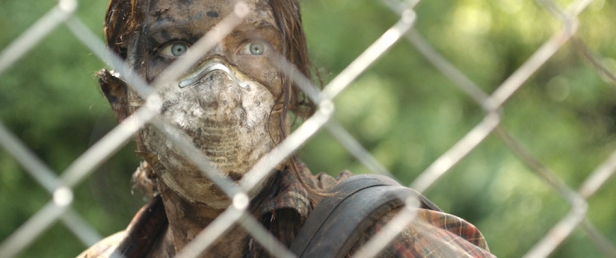
Rod Blackhurst’s Here Alone was rather more subdued but very impressive indeed. Lucy Walters stars as Ann, a woman living, well, alone in the woods in the aftermath of a zombie apocalypse. Through flashbacks we see the extremely traumatic events that led her to this isolated situation, and when she encounters a man and his stepdaughter, she’s immediately apprehensive about forming any kind of connection. The three eventually form a unit, but can it survive the harsh world they live in?
First-time director Blackhurst and writer David Ebeltoft have crafted a quietly compelling and deeply affecting story, using the genre backdrop to explore the character of a woman who has been through a terrible ordeal and is given the possibility of a second chance of a human connection. The set-up, atmosphere and location are immediately reminiscent of The Road, as we so how Lucy and her husband grabbed their baby, gathered supplies and headed to somewhere isolated and (hopefully safe), putting their survival above anyone else’s. Walters (Power) is absolutely superb in the lead role, and there’s strong support from Adam David Thompson (Mozart In The Jungle) as the warmly upbeat Chris and Gina Piersanti as Olivia, who watches her stepfather form a connection with this stranger. It’s very well paced and very easy to become invested in, so when it builds to its finale, the emotional stakes are very high indeed. This is an excellent and moving drama and we hope it finds a UK release soon.
We were also very big fans of Ali Abasi’s gothic pregnancy horror/class commentary Shelley, in which young Romanian housekeeper Elena (Cosmina Stratan) agrees to be the surrogate mother for her wealthy Danish employers. The slightly awkward family unit gets along well until Elena’s pregnancy advances, and her behaviour becomes increasingly erratic. Is there really something wrong with the baby as Elena believes, and whose well-being should mother-to-be Louise (Dorrit Petersen) put first?
Shelley opens with a retro horror title card that makes it clear that this is a gothic horror, but once that bit of stylised fun is out of the way, the film settles in for a slow-burning and incredibly effective blend of social critique, satire and subdued chills. Stratan and Petersen are absolutely fantastic, and Abasi creates a wonderful atmosphere of nail-biting unease. You can read our full review here, but in short, it’s very, very good. Hunt it down.
Back to the main screen, and it was time for Craig Anderson’s seasonal slasher Red Christmas. Diane (Dee Wallace, on good form) and her family gather at her home for one last Christmas before she sells the house, a decision that leads to plenty of…animated discussion. However, the inevitable seasonal bickering will take a backseat when a cloaked figure calling himself Cletus arrives with a message for Diane.
With a title like Red Christmas, our first assumption was that Anderson’s debut feature would be a tribute to Bob Clark’s classic. However, this is much more layered than a simple homage. There are obvious nods to yuletide horrors, and a lot of Dario Argento in the film’s bold colour scheme, but this is a genre movie with a sharp piece of social commentary at its core. Cletus is Diane’s son, the somehow-living result of a botched abortion, and his religious upbringing means that the significance of his arrival on Christmas is lost on no one.
Anderson’s critique of religious conservative attitudes is sharp and bloody, but it’s also refreshingly complex and he enjoys playing with our sympathies. Cletus is an unstoppable killing machine, the physical manifestation of right-to-life aggression, but he’s also a human being who has been brought up with these beliefs that are completely unwavering and non-negotiable, and who is looking for his mother… There are one or two moments that don’t quite work and the cast is so big that some of the characters feel underdeveloped, but it’s great to see a slasher film that doesn’t give the viewer a simple ride. We’re big fans and we’re very excited to see what Anderson does next.
Buried memories are also a key element of Tricia Lee’s Canadian chiller Blood Hunters, which takes its monster movie premise to a surprisingly spiritual place. Ellie Barnes (Lara Gilchrist) is a harried single mother who wakes up in an abandoned hospital, inexplicably heavily pregnant. She finally finds a man who’s been restrained, but the real threat is the monsters that are very hungry and very close behind.
Lee makes good use of her immediately creepy setting, and the “how the hell did we get here?” plot structure works nicely as the band of survivors, including a medical intern, an IT technician and a priest (the always welcome Julian Richings), realise that the key to getting out is remembering why they’re in this situation. While the bloodsuckers make for a decent monster threat, what Lee and writer Corey Brown (working together on their third feature) are more interested in exploring the traumatic memories that are kept just out of reach for their characters. Although it’s never really that scary, there are some impressively nasty gore effects (that birth sequence is difficult to watch), and while the script is patchy, the emotional resolution is earned and rewarding.
Next in the discovery screen was Jason William Lee’s The Evil In Us, which sees a 4th July reunion going very, very wrong. Six friends who haven’t seen each other for years head out to an island cabin to party, but some suspect cocaine turns the people who took into rampaging, rage-driven monsters, the celebration quickly becomes a fight for survival.
The Evil In Us does offer a couple of spins on the classic formula, but for the most part this is a film that sticks to formula: kids go to cabin, something goes wrong, kids die. There’s some solid characterisation and some good performances, and the two main subplots tie nicely into the main narrative, but there’s not really very much here to make it stand out. If you’re looking for a fun, bloody genre movie, you could do better but you could most definitely do worse. As a debut feature, however, it shows promise and we’ll be interested to see what Lee does next.
One of the most talked about films of the festival was up next: Steven DeGennaro’s Found Footage 3D. First up, a disclaimer: we saw this film on a review link which was not in 3D, so our take on the film obviously cannot take that into consideration. That being said, we had a lot of fun with this one.
Screenwriter Andrew (Tom Saporito) is already struggling with the idea of a found footage movie when his director/star Derek (Carter Roy) springs another gimmick on him: 3D. Can they make a 3D found footage movie that isn’t terrible? And can Derek and his ex-wife Amy (Alenda von Stroheim) keep their disagreements off camera? And the location probably isn’t actually cursed…right?
Found Footage 3D is catnip for genre fans who are exhausted by terrible lazy found footage films but haven’t given up hope that the technique can still be used well. As a meta comedy, it’s hilarious, as Andrew despairs at the prospect of coming up with answers to the questions that we all have while watching one of these films, including “Why are they still filming?” and shares all our sentiments about the movies that use the technique badly. The relationships between the characters are very well-drawn and the performances are strong (Scott Allen Perry’s understandably grumpy Carl is particularly good).
It also manages to pull off that extremely difficult horror comedy trick of being properly funny and genuinely scary. Not to give anything away, but DeGennaro keeps things tense with well-placed jump scares and little creepy chills throughout before mounting a very effective final act. We were excited about this one, and we are very pleased to report that it delivers. Funny, scary and inventive, this is highly recommended.
The final film of the festival was Korean zombie movie Train To Busan, which this reviewer had to miss in order to catch the Train To Bournemouth, but judging by the reactions from the sold-out crowd, it went down a storm. You can read our review by Katherine McLaughlin here.
And that was it for Horror Channel FrightFest 2016! It was a fantastic five days of horror, and we’d like to thank the FrightFest team, the staff at Vue Shepherd’s Bush and, of course, the FrightFest crowd, for making it a brilliant experience. We’ll see you next year!
